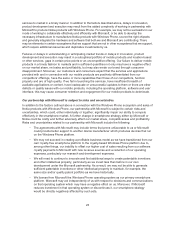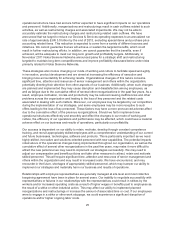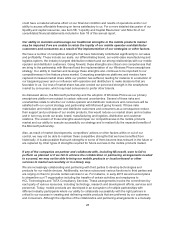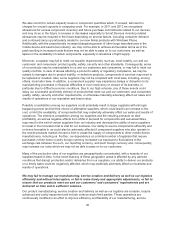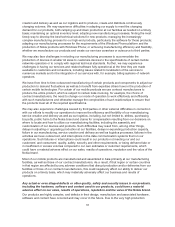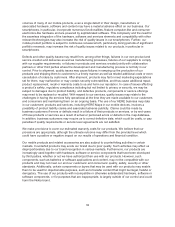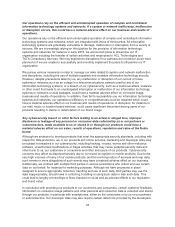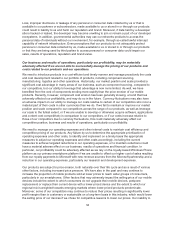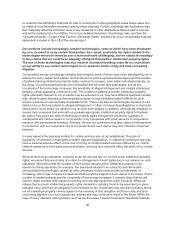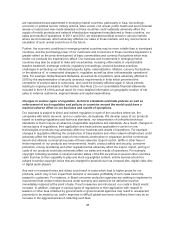Nokia 2012 Annual Report Download - page 30
Download and view the complete annual report
Please find page 30 of the 2012 Nokia annual report below. You can navigate through the pages in the report by either clicking on the pages listed below, or by using the keyword search tool below to find specific information within the annual report.beneficial outcome for each party, our ability to introduce new mobile products that are commercially
viable and meet our and our customers’ and consumers’ quality, safety, security and other standards
successfully and on schedule could be hampered if, for example, any of the following risks were to
materialize:
• We fail to engage the right partners or on terms that are beneficial to us.
• We are unable to collaborate and partner effectively with individual partners and
simultaneously with multiple partners to execute and reach the targets set for the
collaboration.
• The arrangements with the parties we work with do not develop as expected, including their
performance, delivery and timing, or include terms which prove unfavorable to us.
• The technologies provided by the parties we work with are not sufficiently protected or infringe
third parties’ intellectual property rights in a way that we cannot foresee or prevent, or private
information shared with partners is leaked.
• The technologies or products or services supplied by the parties we work with do not meet the
required quality, safety, security and other standards or customer needs.
• Our own quality controls fail.
• We are unable to smoothly and efficiently implement our plans to streamline our IT
organization, including the transfer of some activities and employees to HCL Technologies
and TATA Consultancy Services, or such partners do not deliver as planned.
• The financial condition of our collaborative partners deteriorates which may result in
underperformance by the collaborative partners or insolvency or closure of the business of
such partners.
• Our increasing reliance on collaborative partnering for Nokia-branded or co-branded products
may result in more variable quality due to our more limited control which may have a negative
effect on our reputation and erode the value of the Nokia brand.
If the limited number of suppliers we depend on fail to deliver sufficient quantities of fully
functional products, components, sub-assemblies, software and services on favorable terms
and in compliance with our supplier requirements, our ability to deliver our mobile products
profitably, in line with quality requirements and on time could be materially adversely affected.
Our manufacturing operations depend on obtaining sufficient quantities of fully functional products,
components, sub-assemblies, software and services on a timely basis. Our principal supply
requirements for our mobile products are for electronic components, mechanical components and
software, which all have a wide range of applications in our products.
In some cases, a particular component may be available only from a limited number of suppliers or
from a single supplier. In addition, our dependence on third-party suppliers has increased as a result of
our strategic decisions to outsource certain activities, for example parts of our own chipset as well as
wireless modems research and development, and to expand the use of commercially available
chipsets and wireless modems. Suppliers may from time to time extend lead times, limit supplies,
change their partner preferences, increase prices, have poor quality or be unable to increase supplies
to meet increased demand due to capacity constraints or other factors, which could adversely affect
our ability to deliver our mobile products on a timely basis. If we fail to anticipate customer demand
properly, an over-supply or under-supply of components and production capacity could occur. In many
cases, some of our competitors utilize the same contract manufacturers. If they have purchased
capacity ahead of us, this could prevent us from acquiring the needed products, which could limit our
ability to supply our customers or increase our costs.
29






